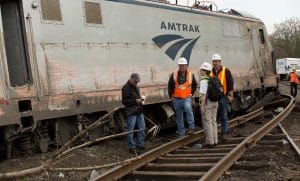
Zanath was born Sept. 10, 1964. After graduating from Padua Franciscan High School in Parma, Ohio, he attended Kent State University and then graduated from Cleveland State University with a Bachelor’s degree in communications.
Following college he worked at Ponderosa restaurant until he hired out with the United Transportation Union as the webpage designer October 8, 1990. Over the past couple of years Zanath took over as the head of the Public Relations Department of the SMART Transportation Division. Zanath was very dedicated to the union and its publications, often staying late to work on and finish projects. Zanath was a laid back, levelheaded supervisor with an unsurpassed knowledge of the inter-workings of the union. He will be missed by not only the PR department in which he worked, but by everyone who knew him.
Zanath was a devout Catholic, who tried to never miss church, even when out-of-town at regional meetings and conventions. He was a member of St. Columbkille Church of Parma, Ohio. He enjoyed the music of Van Halen and many other rock bands. He loved the Cleveland Browns and was a huge Cleveland sports enthusiast. He enjoyed the TV show Star Trek: The Next Generation as well as anything pertaining to James Bond films. Although he was dedicated to his job, he was just as dedicated to leading a good moral life for himself, his entire family and to God. He was a devoted father and husband.
“He was thrilled when John (Zanath’s son) came along,” Retired Public Relations Assistant Eric Eakin said. “He loved his family, he loved his parents and talked to them all the time.”
Surviving Zanath are his wife Lynn, their two children Holly and John, parents Jack and Carole, brother Tom and his wife Debbie, Goddaughter and Niece Erica, parents-in-law Anthony and Frances Grabowski.
Visitation is to be held Sunday, May 31 at Fortuna Funeral Home, 7076 Brecksville Rd., Independence, Ohio from 2:00 p.m. – 7:00 p.m. Prayers are to be held at the funeral home on Monday, June 1 at 9:00 a.m., followed by a Mass of Christian Burial at St. Columbkille Church at 10:00 a.m. Interment will follow at All Saints Cemetery.
Author: paul
(The following is a joint statement by John Previsich, President, SMART Transportation Division and Dennis R. Pierce, National President of the Brotherhood of Locomotive Engineers and Trainmen, regarding questions that have arisen since the fatal Amtrak derailment in Philadelphia on May 12, 2015.)
CLEVELAND, May 19 — Members of BLET’s Safety Task Force and SMART Transportation Division’s National Safety Team, in addition to representatives from the Brotherhood of Maintenance of Way Employees Division of the Teamsters Rail Conference (BMWED), are working with the National Transportation Safety Board (NTSB) to assist in the investigation of the catastrophic May 12 derailment of Amtrak Train 188.
Significant progress has been made in understanding how the accident occurred on May 12. That portion of the investigation is not yet complete, however, and even more work needs to be done to determine why the events
of that tragic night transpired the way they did.
BLET and SMART–TD do not make official comments about any ongoing NTSB investigation. Due to the number of press inquiries concerning issues not under investigation, however, we are providing the following information on why Amtrak trains on the Northeast Corridor are manned by a lone engineer in the control cab and why Positive Train Control (PTC) has not been installed on the Corridor. The answers to both questions begin with the United States Congress.
Why a One-Person Train Crew?
In 1981, Congress passed legislation (the Northeast Rail Service Act of 1981) that ended the previous Conrail requirement that there be a second crew member in the control cab of commuter rail trains on the Northeast Corridor. Armed with that legislative precedent — and mindful of where its funding originates — Amtrak has since 1983 refused to crew Northeast Corridor trains with more than one employee in the cab – the locomotive
engineer. Although BLET and SMART–TD have steadfastly maintained that there should be two crew members in the cab of all trains to ensure public
safety, only Congress can change the 1981 legislation that reduced crew size on the Northeast Corridor. But this is only one piece of a very large, complex puzzle.
Why No Positive Train Control?
On the heels of another catastrophic railroad accident in Chatsworth, CA, the federal government mandated in 2008 that Positive Train Control (PTC) be put in effect by the end of this year. That was seven years ago. Even with that mandate in place, and with the exception of some railroads such as BNSF Railway, the industry at large has spent the interim finding reasons to avoid implementing PTC technology. They have created the situation about which they all now complain — they say they cannot meet the December 31, 2015 deadline. Each death caused by the delay of PTC implementation is one too many, yet Congress is preparing to consider a blanket 5-year extension to 2020. This is most certainly not in the public interest.
Since 2005, the NTSB has completed 16 investigations of railroad accidents that could have been prevented or mitigated with PTC. These 16 accidents
claimed 52 lives — many being BLET and SMART–TD members — and injured 942 people, with damages totaling hundreds of millions of dollars. NTSB has publicly stated that the accident on May 12, 2015 was also PTC preventable. There is no disagreement over the value of PTC technology.
That said, there is no technology available today that can ever safely replace a second crew member in the cab of the locomotive. The only thing on a locomotive that is not a machine is the crew. The uncontrolled external environment in which trains are operated along with regulatory and operational demands of a safe transportation service demand a crew of at least two fully trained and qualified employees in the control cab of
every train. PTC is only a safety overlay that ensures a safer operation, and no technology can replace the level of safety provided when two crew members are on board and can serve as a check and balance to one another.
Even with all the safety-related technology that the government has mandated on commercial airlines, the public would never accept an airline operation with a single person in the cockpit. There is no reason that
rail employees and rail passengers’ lives should be viewed any differently.
Contrary to what some in government may say, the only place that crew size and PTC do connect is when it comes to funding. That is especially true in the case of Amtrak, because the government has woefully underfunded Amtrak since its inception. Additional crew members and new technology both cost money, and so long as those in Congress see fit to underfund the operation, they undermine their own mandate and shortchange the safety of the traveling public.
# # #
The SMART Transportation Division is headquartered in the Cleveland suburb of North Olmsted, Ohio. It is a broad-based, transportation labor union representing about 125,000 active and retired railroad, bus, mass transit and airline workers in the United States. It is a division of the International Association of Sheet Metal, Air, Rail and Transportation Workers based in Washington, D.C.
The Brotherhood of Locomotive Engineers and Trainmen represents more than 55,000 professional locomotive engineers and trainmen throughout the United States. The BLET is the founding member of theRail Conference, International Brotherhood of Teamsters.
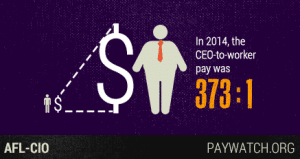
While an S&P 500 company CEO averaged $13.5 million per year, the average production worker in the United States earned $36,000 per year—an alarming ratio of 373-to-1.
This 2015 edition of Paywatch (www.paywatch.org) shines its light on Walmart, where the CEO of the nation’s largest employer, Doug McMillon, earns $9,323 an hour. An entry-level Walmart employee earning just $9 an hour would have to work for 1,036 hours just to equal the pay McMillon earns in one hour. That’s nearly a half a year, assuming that employee works 40-hour weeks. The report also also delves into the wealth of the six Walton family members who have more combined wealth than the total wealth of 43 percent of America’s working families.
For more information on CEO pay, visit www.paywatch.org.

Due to this impasse, Democratic leaders predict that they can muster 41 votes to block the bill from being debated.
Update: 45 Senators voted against closure, effectively blocking the measure.
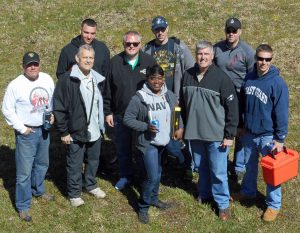
As title sponsor, SMART Played a significant role in the event’s continued growth by securing additional sponsors and encouraging them to donate shooting spots to wounded veterans or active duty military men and women. SMART General President Joseph Sellers, Jr. and former General President Nigro gave speeches and recognized the sacrifice of the military service men and women in attendance.
“The New Jersey Shoot brought together the young and old, men and women, novice and experienced shooters, active service members and veterans, members of all different union trades and union partners, through a shared passion for the outdoors and the shooting sports,” said General President Sellers. “Thanks to those who participated, USA and our sponsors for another great event, all in support of this worthy cause.”
The Union Sportsmen’s Alliance is a union-dedicated, 501(c)(3) nonprofit organization whose members hunt, fish, shoot and volunteer their skills for conservation. The USA is uniting the union community through conservation to preserve North America’s outdoor heritage.

Lawsuits filed by the Associated Builders and Contractors and other anti-worker groups have been filed in federal courtrooms in Texas and Washington, DC. The Associated Builders and Contractors is a high profile anti-worker group that claims to represent construction employers though only a small percentage of its membership actually is based in the industry.
Charles Holt has been named Administrator for the National Energy Management Institute Committee (NEMIC). Holt, who took over the top spot at NEMIC when James Page left to head the International Training Institute, had been the director of research for NEMIC.
A former instructor for the journeymen-apprentice training fund in Pittsburgh, PA, Holt is a graduate of Ohio State’s adult education program and also holds a Letters, Arts and Science degree from Pennsylvania State University. He previously held positions at Sheet Metal Local 12 in Pittsburgh as Business Agent and Business Manager/Financial Secretary-Treasurer.
Holt has served as a Technical Committee member for the National Fire Protection Association (NFPA) Standards 90 A&B, 80, and 105.
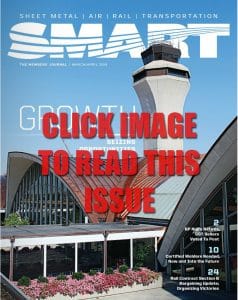
Some of the highlights from this issue include:
GP Nigro: A Fond Farewell; GST Sellers: Growing Stronger Together
Certified Welders In High Demand
Rebuilding An Iconic Copper Roof In St Louis
Local 31 Members Keep Work In House
Growth Through New Organizing Victories
Canadian News
SMART Fights Back Against Attacks On Working Families
SMART TD In Talks On New Nationwide Agreement
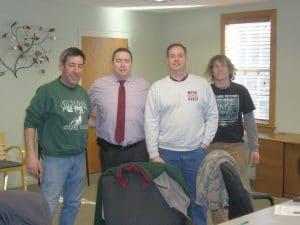
This agreement with Phil’s HVAC is unique because it focuses on the residential and light commercial market that is typically outside the geographic core of the majority of union building trades agreements. This is evidenced almost anywhere in the country, where a union member can walk outside the city limits of any major metropolitan area and find that the farther out he or she travels, the lower the union density.
According to Local 17 Business Manager Robert Butler, “We are not content with standing still in the geographic areas we are already strong in. We are going to continue using every tool in our playbook to find more job opportunities for members.”
Concentrated in the Boston suburbs, Phil’s HVAC performs service calls for residential and commercial customers of all sizes. HVAC service work in the light commercial and residential markets is expected to be one of the fastest growing occupational fields in coming years, with millions of units installed during the economic boom years coming up for extensive service and repair.
According to Politico, The National Labor Relations Board’s (NLRB) newest focus might be on limiting the right-to-work movement’s pitch of required representation of non-union workers. In a call for briefs yesterday, the agency said it may allow a union to collect a fee from a non-member in a right-to-work state if that member is not a dues paying member. Under current NLRB rules and regulations, unions are prohibited from collecting any fees from non-members in right-to-work states, regardless of whether those members actually use that union’s resources in a conflict with their employer. That’s what the 1947 Taft-Hartley Act, which created and regulates the circulation of right-to-work laws in the U.S., has always been understood to mean.
Legal analysts say the NL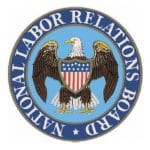
Anti-labor groups believe the board will make the change. “When this board is asking for an amicus brief on the reconsideration of a rule, the majority’s already decided that it wants to change the rule,” said Michael Lotito, a management-side attorney at Littler Mendelson. “This is a signal from this board that [says]: ‘we’re going to push back against the expansion of these right-to-work actions.’
Currently, labor unions are the only institutions in the United States that are required to represent non-contributing members. Anti-Labor groups have used this to mislead non-union workers with the promise of free representation without the requirement of paying dues.
